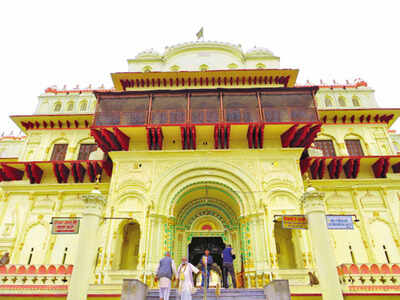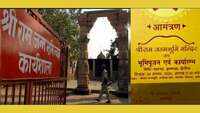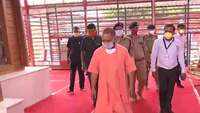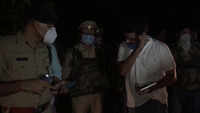
Kamala Devi recalls coming to Ayodhya as a young bride about six decades ago while in her mid-teens. These days, after her husband’s death, she spends time trying to run her tiny shop. Her son works in the southern part of India, her grandson has returned from Maharashtra after losing job. But rising above these troubles, she draws immense optimism from one date – August 5.
This optimism is shared by many in the region, which will witness its most significant day in centuries. While the positive impact of the iconic temple’s construction on the region and beyond is undeniable, it would be even more significant if various stakeholders – ranging from the central and state governments to the local populace – made the most of the economic opportunity that exists.
Till now, the temples of the town witnessed a trickle of pilgrims and curiosity-driven travellers. That number will climb steadily now. But for the town to leverage the full benefit of these visitors, a transformation is needed that must go beyond the temple. Perhaps the basis for planning must be to retain the interest of travellers beyond a darshan at the main temple.
A town dotted with heritage:
A simple walk around Ayodhya reveals it to be an old town, with so many medieval houses and temples. To a traveller, the first point of interest lies outside the town at Mani Parvat. The site attracts both the pilgrims and history lovers.
To the former, it is the site where Hanuman dropped a fragment of the mountain while returning with 'Sanjeevani booti' to revive a wounded Laxman. It is also considered the site where Sita would come during the month of Shrawan to relax on a swing. The place comes to life during the annual Jhulnotsav, which commemorates the beginning of this month. To a history buff, the site is a mound which, if excavated, could reveal Mauryan-era remains.
Inside the town the most visited place – quite literally, the high point - is the Hanuman Garhi temple. From a distance, the place looks like a small fort, a result of protective walls having been constructed around it. While scholars date the shrine here as being from the 10th century CE, oral traditions take it to a more ancient period. Medieval accounts connect the protection of the shrine to a Nawab of Awadh.
From Hanuman Garhi, a series of winding lanes take a visitor to the highly protected site of the janmasthan. And it is while walking through these lanes and beyond that a visitor gets to see nuggets of the town’s history. There is the Dashrath Mahal. In stark contract is Kanak Bhavan with its creamy yellow exteriors.
Looming above the surrounding buildings is Rajdwar Temple. With a huge circular mandapa in front and an inner sanctum topped by a shikhara that rises high, it is one of the town’s most distinct structures.
Leveraging the past:
The first step to leveraging the rich medieval heritage of this town, for economic gains for the locals, is to preserve it. A listing and documentation of the town’s heritage would be an excellent idea for which the Centre and state can plan together, perhaps also reach out to Indian National Trust for Art and Cultural Heritage (INTACH) for expertise.
With many buildings being in private hands, a heritage structure being knocked over to make way for a modern-day utilitarian building is par for the course. Hence, even more important than one-off efforts at preservation is to give the local community a stake in its upkeep.
Seed in the idea of heritage homestays, income from which can help owners maintain their aging properties. Ayodhya also has a palace – perhaps the former ruler, who still owns this building, can be motivated to use his space for a museum and interpretation centre.
The proposed airport in Faizabad can be fast-tracked for commercial usage.
The opportunity:
To understand the potential, lets travel to the Cambodian city of Siem Reap. The city had the magnificent Angkor complex. But it worked to build a worldclass tourist infra over time and the results show.
Over 50% of the population is engaged in the manpower-intensive tourism sector. In 2018, Siem Reap international airport saw 14.3 lakh foreign tourist arrivals. That figure makes those of Chennai (7.9 lakh) and Bangalore (6.1 lakh) pale and compares favourably to Mumbai (16.5 lakh). (Source: https://tinyurl.com/indtour18) And that’s just Siem Reap, gateway to the tourist destination of Angkor. As the heart of Indic civilization whose strands are global, Ayodhya is far superior.
The holy city has the potential to become an economic hub for Uttar Pradesh. Whether that potential will be achieved depends on the ambitions of the people and their elected representatives.
If they put everything into it, the result could be the creation of a model heritage and religious town, an example to be emulated across India. And families such as that of Kamala Devi may not have to travel far and wide to seek employment. That lady, and hundreds like her, wait in hope.
This optimism is shared by many in the region, which will witness its most significant day in centuries. While the positive impact of the iconic temple’s construction on the region and beyond is undeniable, it would be even more significant if various stakeholders – ranging from the central and state governments to the local populace – made the most of the economic opportunity that exists.
Till now, the temples of the town witnessed a trickle of pilgrims and curiosity-driven travellers. That number will climb steadily now. But for the town to leverage the full benefit of these visitors, a transformation is needed that must go beyond the temple. Perhaps the basis for planning must be to retain the interest of travellers beyond a darshan at the main temple.
A town dotted with heritage:
A simple walk around Ayodhya reveals it to be an old town, with so many medieval houses and temples. To a traveller, the first point of interest lies outside the town at Mani Parvat. The site attracts both the pilgrims and history lovers.
To the former, it is the site where Hanuman dropped a fragment of the mountain while returning with 'Sanjeevani booti' to revive a wounded Laxman. It is also considered the site where Sita would come during the month of Shrawan to relax on a swing. The place comes to life during the annual Jhulnotsav, which commemorates the beginning of this month. To a history buff, the site is a mound which, if excavated, could reveal Mauryan-era remains.
Inside the town the most visited place – quite literally, the high point - is the Hanuman Garhi temple. From a distance, the place looks like a small fort, a result of protective walls having been constructed around it. While scholars date the shrine here as being from the 10th century CE, oral traditions take it to a more ancient period. Medieval accounts connect the protection of the shrine to a Nawab of Awadh.
From Hanuman Garhi, a series of winding lanes take a visitor to the highly protected site of the janmasthan. And it is while walking through these lanes and beyond that a visitor gets to see nuggets of the town’s history. There is the Dashrath Mahal. In stark contract is Kanak Bhavan with its creamy yellow exteriors.
Looming above the surrounding buildings is Rajdwar Temple. With a huge circular mandapa in front and an inner sanctum topped by a shikhara that rises high, it is one of the town’s most distinct structures.
Leveraging the past:
The first step to leveraging the rich medieval heritage of this town, for economic gains for the locals, is to preserve it. A listing and documentation of the town’s heritage would be an excellent idea for which the Centre and state can plan together, perhaps also reach out to Indian National Trust for Art and Cultural Heritage (INTACH) for expertise.
With many buildings being in private hands, a heritage structure being knocked over to make way for a modern-day utilitarian building is par for the course. Hence, even more important than one-off efforts at preservation is to give the local community a stake in its upkeep.
Seed in the idea of heritage homestays, income from which can help owners maintain their aging properties. Ayodhya also has a palace – perhaps the former ruler, who still owns this building, can be motivated to use his space for a museum and interpretation centre.
The proposed airport in Faizabad can be fast-tracked for commercial usage.
The opportunity:
To understand the potential, lets travel to the Cambodian city of Siem Reap. The city had the magnificent Angkor complex. But it worked to build a worldclass tourist infra over time and the results show.
Over 50% of the population is engaged in the manpower-intensive tourism sector. In 2018, Siem Reap international airport saw 14.3 lakh foreign tourist arrivals. That figure makes those of Chennai (7.9 lakh) and Bangalore (6.1 lakh) pale and compares favourably to Mumbai (16.5 lakh). (Source: https://tinyurl.com/indtour18) And that’s just Siem Reap, gateway to the tourist destination of Angkor. As the heart of Indic civilization whose strands are global, Ayodhya is far superior.
The holy city has the potential to become an economic hub for Uttar Pradesh. Whether that potential will be achieved depends on the ambitions of the people and their elected representatives.
If they put everything into it, the result could be the creation of a model heritage and religious town, an example to be emulated across India. And families such as that of Kamala Devi may not have to travel far and wide to seek employment. That lady, and hundreds like her, wait in hope.

Coronavirus outbreak
Trending Topics
LATEST VIDEOS
City
 'Wanted to teach Hindus a lesson' using political power, ex-AAP councillor Tahir Hussain confesses
'Wanted to teach Hindus a lesson' using political power, ex-AAP councillor Tahir Hussain confesses  48-hour countdown to Ram Mandir Bhumi Pujan in Ayodhya; invitation cards sent
48-hour countdown to Ram Mandir Bhumi Pujan in Ayodhya; invitation cards sent  UP CM Yogi Adityanath takes stock of preparations in Ayodhya ahead of Ram Temple bhumi pujan ceremony
UP CM Yogi Adityanath takes stock of preparations in Ayodhya ahead of Ram Temple bhumi pujan ceremony  J&K: Army Jawan abducted from Kulgam, vehicle set ablaze; massive search operation launched
J&K: Army Jawan abducted from Kulgam, vehicle set ablaze; massive search operation launched
More from TOI
Navbharat Times
Featured Today in Travel
Quick Links
Kerala Coronavirus Helpline NumberHaryana Coronavirus Helpline NumberUP Coronavirus Helpline NumberBareilly NewsBhopal NewsCoronavirus in DelhiCoronavirus in HyderabadCoronavirus in IndiaCoronavirus symptomsCoronavirusRajasthan Coronavirus Helpline NumberAditya ThackerayShiv SenaFire in MumbaiAP Coronavirus Helpline NumberArvind KejriwalJammu Kashmir Coronavirus Helpline NumberSrinagar encounter
Get the app





